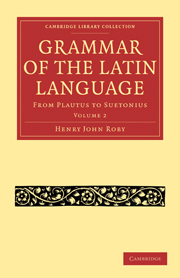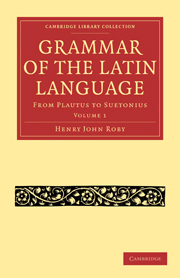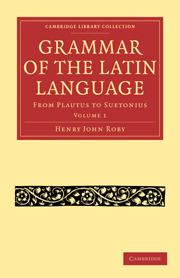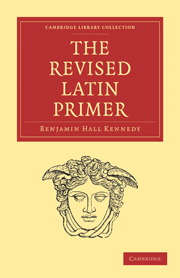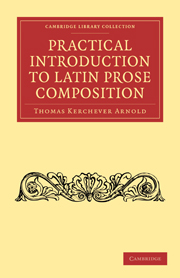Grammar of the Latin Language
Henry John Roby (1830–1915) was a Cambridge-educated classicist whose influential career included periods as a schoolmaster, professor of Roman law, businessman, educational reformer and Member of Parliament. His two-volume Grammar of the Latin Language reveals his innovative, descriptive approach to grammar, which situates thorough analysis of the Latin language within the historical context of the writings themselves, or, as Roby puts it, setting 'example above precept' in order to put grammar 'in the proper light, as an account of what men do say, not a theory of what they should say'. Drawing examples from the corpus of classical writings dating from circa 200 BCE. to 120 CE; this second volume (1875) is devoted to syntax, including a complete analysis of cases, tense, and mood. A work of remarkable breadth and depth, Roby's book remains an essential resource for both historical linguistics and the study of Latin grammar.
Product details
May 2010Paperback
9781108011235
672 pages
216 × 38 × 140 mm
0.84kg
Available
Table of Contents
- Preface
- Book IV. Syntax:
- 1. Classification of words
- 2. Parts of a simple sentence and use of parts of speech
- 3. Of the different kinds of sentences
- 4. Order of words and sentences
- 5. Use of noun inflexions
- 6. Use of cases
- 7. Use of nominative case
- 8. Use of accusative case
- 9. Use of dative case
- 10. Use of locative and ablative cases
- 11. Use of genitive cases
- 12. Use of infinitive
- 13. Tenses of infinitive, when used
- 14. Use of verbal nouns, especially the gerund and gerundive
- 15. Use of verb inflexion
- 16. Use of verbal inflexions of person and number
- 17. Of indicative and imperative moods and their tenses
- 18. Of the subjunctive mood and its tenses
- 19. Typical examples of subjunctive mood and its tenses
- 20. Use of moods in hypothetical and conditional clauses
- 21. Use of subjunctive mood to express desire
- 22. Use of subjunctive mood to express causation
- 23. Use of subjunctive mood to express alien or contingent assertions
- 24. Of reported speech
- Supplement
- Index.

